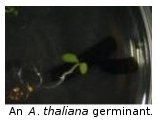Ecological genetics using Arabidopsis thaliana
For much of our work at present, we use Arabidopsis thaliana as a study system. A. thaliana is well known for its use in molecular-genetic studies. Being a recent addition to the flora of North America, and distributed over a wide geographic range, it also has an extremely interesting ecology. Because of the genetic tools developed for A. thaliana, it offers a powerful system for investigating the genetic basis of species introductions, range expansion, and adaptation to broad geographies. Our lab has been studying the seed germination, seed dispersal, and life history variation of A. thaliana.
Phenotypic plasticity, parental effects, and life-histories
 Phenotypic expression is the outcome of the interaction between genotypes and environments. We study how organisms respond phenotypically, developmentally, and behaviorally to their environment, and how in turn genetically based traits of organisms determine the ecological environments they experience. We are interested in genetic mechanisms of phenotypic expression, natural selection on phenotypic plasticity, and ecological and evolutionary consequences of phenotypic plasticity. Offspring traits are frequently influenced by the environment experienced by their parents. Such parental effects are trans-generational plasticity. Because they link one generation to the next, and late developmental stages to early ones, parental effects are integral to organisms’ life cycles.
Phenotypic expression is the outcome of the interaction between genotypes and environments. We study how organisms respond phenotypically, developmentally, and behaviorally to their environment, and how in turn genetically based traits of organisms determine the ecological environments they experience. We are interested in genetic mechanisms of phenotypic expression, natural selection on phenotypic plasticity, and ecological and evolutionary consequences of phenotypic plasticity. Offspring traits are frequently influenced by the environment experienced by their parents. Such parental effects are trans-generational plasticity. Because they link one generation to the next, and late developmental stages to early ones, parental effects are integral to organisms’ life cycles.
The life cycle of plants and other organisms is determined by phenology—the timing of developmental transitions. In the wild, developmental transitions occur in response not only to intrinsic developmental states but also in response to extrinsic environmental conditions. Yet the external environment experienced by later life stages depends on the plastic developmental responses of earlier stages. The environmental conditions under which a seed germinates, for example, determines the conditions experienced by post-germination stages, making germination cuing a critical determinant of plant life cycles. Likewise, through parental effects, the environmental conditions during reproduction strongly influence germination behavior of offspring. A life cycle, therefore, is the outcome of interactions between particular life stages with the environment that is in part determined by previous life stages. We study the genetic basis of developmental responses to environmental conditions and how genetically based traits influence the environment experienced by organisms, in order to understand the evolution of life cycles in dynamic ecological environments.
Germination: development & adaptation
 Being among the earliest phenotypes expressed by plants, seed germination behavior can strongly influence adaptive dynamics. Germination behavior is exquisitely sensitive to environmental conditions, and as such can be a precise method of habitat selection in plants. We study the genetic basis of germination responses to environmental cues and test how natural variation in germination contributes to adaptation to variable environments. Germination offers an ideal framework for studying how the sequence of development–the timing of the expression of particular phenotypes over the lifetime of individuals–influences the dynamics of adaptation.
Being among the earliest phenotypes expressed by plants, seed germination behavior can strongly influence adaptive dynamics. Germination behavior is exquisitely sensitive to environmental conditions, and as such can be a precise method of habitat selection in plants. We study the genetic basis of germination responses to environmental cues and test how natural variation in germination contributes to adaptation to variable environments. Germination offers an ideal framework for studying how the sequence of development–the timing of the expression of particular phenotypes over the lifetime of individuals–influences the dynamics of adaptation.
We have studied a number of genes that are involved in germination responses to temperature, including the phytochromes, Delay of Germination 1 (DOG1), and Flowering Locus C (FLC). We have found evidence of strong pleiotropy between germination and flowering regulation, and have measured natural selection on particular chromosomal regions containing natural variants of germination genes. From these studies, we know that the timing of germination influences the timing of reproduction and natural selection on reproductive timing; in turn, the timing of reproduction influences germination, the genetic basis of germination, and natural selection on germination. Interactions across life stages therefore determine overall life-history expression and can result in variable natural selection that potentially maintains genetic variation in life-history genes.
The evolution of seed dispersal
Dispersal is one of the primary factors that influence the rate and outcome of evolution. In plants, seed dispersal is primarily determined by the maternal plant rather than the dispersed offspring. Such maternal effects change evolutionary dynamics. We have studied the adaptive value of seed dispersal of sea rocket, Cakile edentula, and have investigated the quantitative-genetic basis of seed dispersal in Arabidopsis thaliana.
We are currently studying the evolution of seed dispersal in the tribe Brassiceae, in collaboration with Elena Kramer and Jocelyn Hall, by combining phylogenetic analysis of the tribe, morphological and functional studies of fruit anatomy and its relation to seed dispersal, and molecular developmental genetics. Other projects on this research system concern adaptive differentiation across the genus and the evolution of reproductive isolation.



